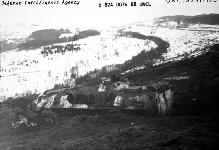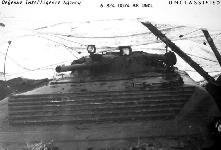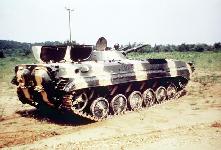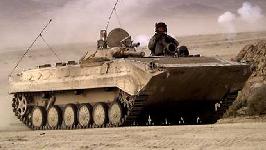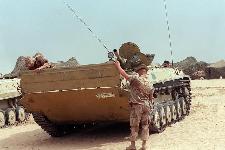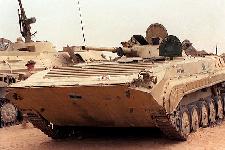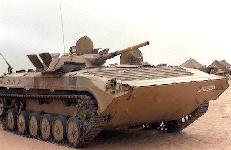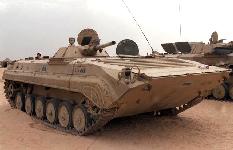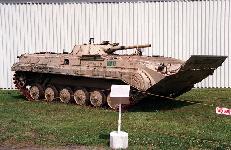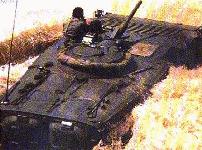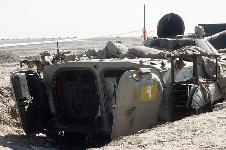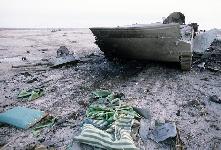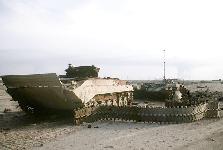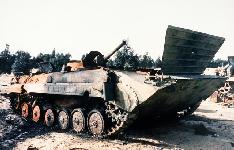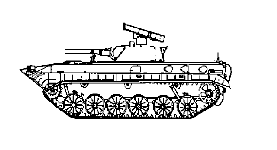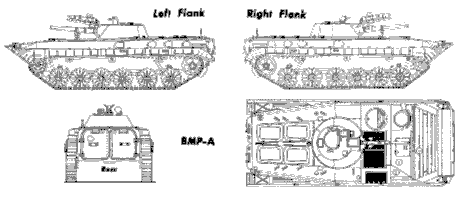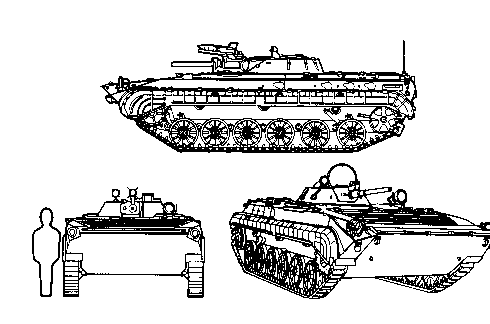
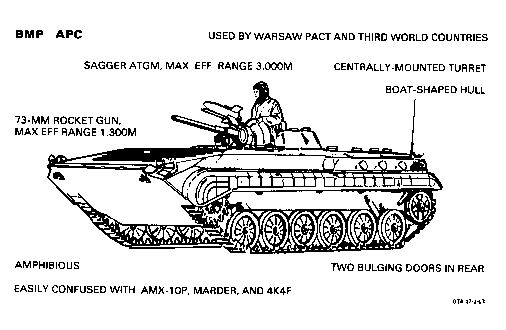




A combination of effective antitank firepower, high mobility, and adequate protection made the BMP a formidable addition to the inventory of Soviet motorized rifle units. Designed to suit the demands of high-speed offensive in a nuclear war, it carries a 73mm, 2A20 gun with maximum rounds of 40 and maximum range of over 7,000 ft. Its 73-mm main gun fires a rocket-assisted, fin- stabilized HEAT projectile with an effective range of 800 meters medium (capable of successfully engaging tanks at ranges up to 1,300 meters) and is equipped with an automatic loader. The main armament of the BMP1 is unusual, in that it fires the same ammunition as the RPG-7 infantry rocket propelled grenade launcher. A launching rail for the AT-3 Sagger antitank guided missile is located above the gun for longer range antitank capability (up to 3,000 meters).
The BMP is a fully armored amphibious infantry combat vehicle (AICV). Its low silhouette hull has a sharp sloping front with a conspicuously ridged surface. A centrally located, extremely flat, truncated cone turret mounts a 73-mm smoothbore gun and a 7.62-mm coaxial machine gun. A launching rail for SAGGER missiles is attached above the gun. The 290 hp, water-cooled, 6- cylinder diesel engine is located at the right front, while the driver's hatch is at the left front, directly in front of the commander's hatch which mounts an IR searchlight. The gunner's hatch is on the left side of the low turret roof. To the rear of the turret there are four large hatches in the roof of the troop compartment, as well as two large exit doors in the rear. There are four firing ports in each side of the troop compartment and one in the left rear door. The suspension has six unevenly spaced road wheels of the PT-76 type, with three track support rollers and a front drive sprocket.
The BMP is amphibious, propelled through water by its tracks rather than using the waterjet propulsion of the PT-76, and has the range and speed necessary to keep up with the fast-moving tanks it normally follows in offensive formations.
The BMP has a three-man crew, including the vehicle commander, who becomes the squad leader when the infantry passengers dismount through the rear exit doors. However, vision blocks and firing ports in the sides and rear of the troop compartment allow the infantrymen to fire assault rifles (AKM or AK-74) and light machine guns (PKM or RPK-74) from inside the vehicle on the move. The troops also carry the RPG-7 or RPG-16 AT grenade launcher and the SA-7/ GRAIL or SA-14 SAM, either of which can be fired by a passenger standing in a rear hatch. When buttoned up, crew and passengers have NBC protection in the pressurized and filtered hull, which allows them to operate regardless of the outside environment.
The BMP is equipped with an infrared searchlight, periscopes, and sights for night operations and has a capability to make its own smoke screen by injecting diesel fuel into the exhaust manifold.
Because of the extreme vulnerability demonstrated by the BMP in the 1973 Middle East war, there has been extensive debate in the Soviet Army as to how this vehicle should be used in battle. The BMP has relatively thin armor (maximum thickness 19 mm in the hull, 23 mm in the turret) which provides protection against .50 caliber armor-piercing rounds only over the 60° frontal arc, and the vehicle is extremely vulnerable to ATGM and tank fire. Due to the compactness of the vehicle, critical areas such as the engine compartment and ammunition storage area (on the right side), fuel cells (in the rear doors), and the troop compartment are located in such a manner that penetration anywhere on the vehicle normally will result in a mobility, firepower, or personnel kill.
Because of limited capability to depress the main gun, the BMP is unable to engage tanks and APCs from good hull-down positions, and so is very vulnerable to enemy fire when it exposes itself to engage targets.
Although the turret can traverse 360 degrees, the main gun and coaxial machine gun must be elevated to clear the IR searchlight on the commander's cupola, creating a dead space for both weapons between 10:00 and 11:00 o'clock. This limitation could be a serious problem during an engagement since an automatic cutoff on the electrically operated turret halts movement until the gun is elevated.
The BMP can maintain its top speed (70 km/h) for only short periods of time because of the high amount of vibration and the possibility of transmission failure. Due to the complicated loading mechanism and the lack of stabilization, it is not possible to accurately fire the 73-mm gun or the coaxial machine gun while on the move over rough terrain. The BMP must be stationary when firing and tracking the SAGGER ATGM. The SAGGER is difficult to reload and cannot be reloaded at all under NBC conditions. The land navigation system must be zeroed every 30 minutes.
The BMP infantry combat vehicle also has become the basis for a family of variants which perform other roles. Each variant bears a designation corresponding to the year in which it was first observed. Many BMPs now mount either the improved, semiautomatic AT-3c/SAGGER or the new AT -4/SPIGOT or AT-5/SPANDREL ATGM.
Specifications | |
| LENGTH | 22 FT |
| WIDTH | 9 FT |
| HEIGHT | 7 FT |
| WEIGHT | 14 TONS |
| Main Armament (caliber, model) | 73-mm 2A38 gun |
| ammunition type | HEAT-FS, HE-Frag |
| range, effective (m) | 800 |
| rate of fire (rpm) sustained/maximum | 10 |
| stabilized | |
| elevation/traverse (degrees) | |
| basic load | 40 |
| Secondary Armament | AT-4a/5a ATGM |
| range, effective (m) | 2000/4000 |
| rate of fire, cyclic/practical (rpm) | |
| penetration (mm @ m range) | 600/650 |
| basic load | 5 |
| Auxiliary Armament | 7.62-mm PKT MG |
| range, effective (m) | |
| ammunition type | |
| rate of fire, cyclic/practical (rpm) | |
| penetration (mm) | |
| basic load | 2000 |
| Auxiliary Armament | |
| model | |
| rate of fire, cyclic/practical (rpm) | |
| penetration (mm @ m range) | |
| basic load | |
| vehicle characteristics | |
| night sights | |
| commander | IR |
| gunner | II |
| driver | IR |
| speed, road/off-road (kph) | 65/45/8 |
| range, road/off-road (km) | 600/570 |
| trench crossing (width x height m) | 2.5x0.8 |
| grade x side slope (degrees) | 31x17 |
| ground clearance (mm) | 390 |
| fording (m) | swim |
| armor, hull/turret (mm) | 19/23 |
| crew | 3 + 8 |
| Night Firing Sights | Image Intensifier range 1200 m. |


